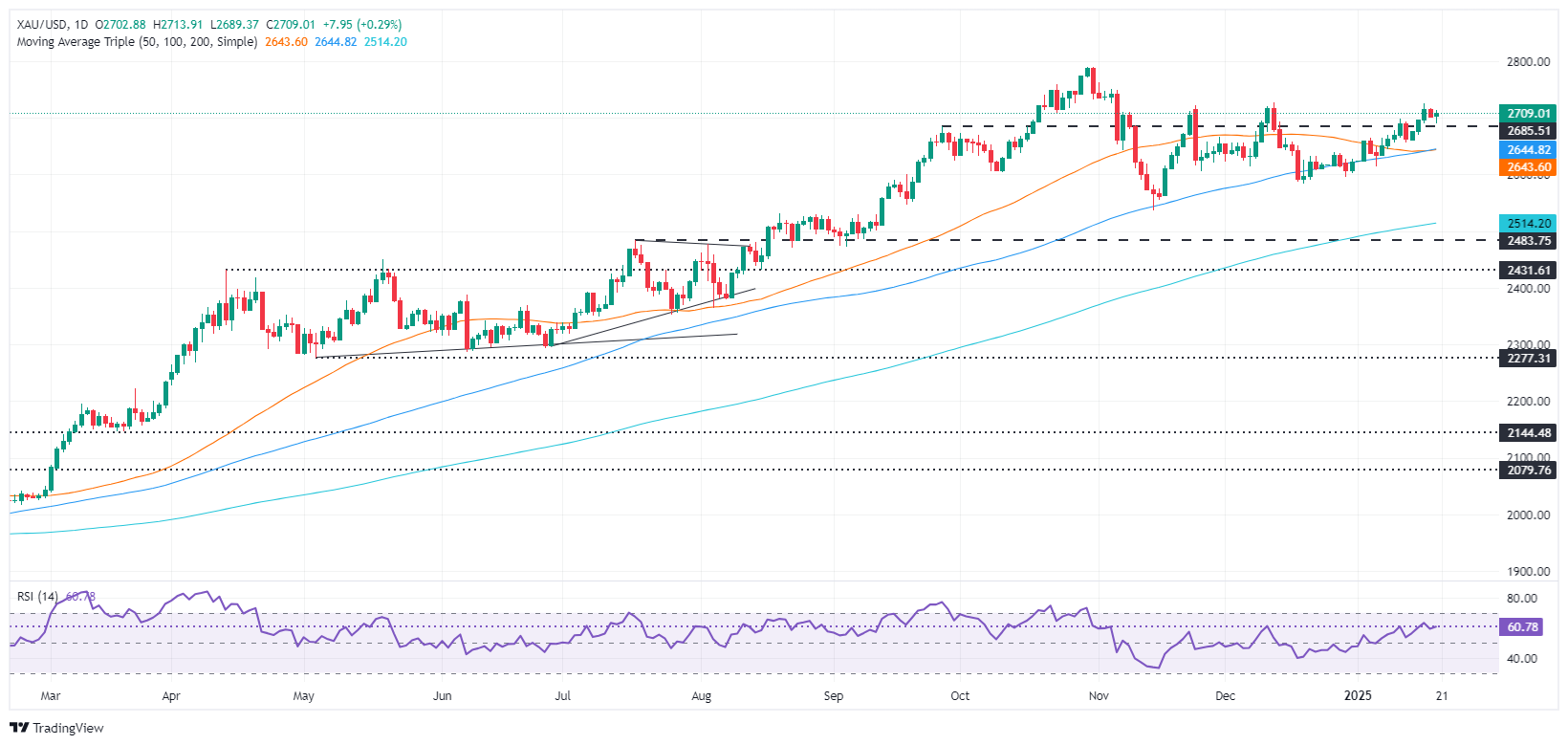Gold prices edge higher as Trump assumes Presidency
- Gold rises as US Dollar dips to nine-day low during Trump's inauguration speech.
- Trump declares a national emergency on energy and immigration, aiming to reshape US policies.
- Upcoming US Jobless Claims and Flash PMIs expected to provide direction for the US economy.
Gold prices climbed moderately on Monday amid thin liquidity conditions after Donald Trump was sworn in as the 47th President of the United States (US). The Greenback weakened during his speech as he set aside his aggressive tariff policies, which could stoke inflation and prevent the Federal Reserve (Fed) from easing policy. At the time of writing, XAU/USD trades at $2,709, up 0.27%.
US President Donald Trump declared a national emergency on energy and at the southern border to overhaul energy and immigration policies. The former is aimed at filling up strategic reserves and exporting American oil, while the immigration policy proposes to return millions of “criminal aliens to the places from which they came.”
In the meantime, his speech eased his rhetoric on trade, but an article in The Wall Street Journal mentioned the issuance of a broad memorandum that directs federal agencies to study trade policies and evaluate US trading relationships with China, Canada and Mexico.
The US Dollar weakened to a nine-day low during the inauguration speech, according to the US Dollar Index (DXY), which measures the buck’s performance against a basket of peers. The DXY tumbled to 107.95 before matching those earlier losses and recovering above the 108.00 figure.
This week, the US economic docket will feature Initial Jobless Claims data, S&P Global Flash PMIs and housing data.
Daily digest market movers: Gold price ticks higher amid weaker US Dollar
- Gold fell as real yields edged lower one basis point on Friday. Measured by the 10-year Treasury Inflation-Protected Securities (TIPS) yield, it was virtually unchanged at 2.20%.
- The US 10-year Treasury bond yield was unchanged at 4.611%, which halted the advance in Gold.
- Geopolitical risks had eased amid a ceasefire in the Middle East, with Hamas releasing three female hostages in exchange for 90 Palestinians held in Israeli prisons, reported Reuters.
- Market participants are pricing in near-even odds that the Fed will cut rates twice by the end of 2025, with the first reduction occurring in June.
XAU/USD technical outlook: Gold price consolidates above $2,700
Gold price remains sideways trading, yet above the $2,700 mark but unable to crack the December 12 daily high of $2,725 which would clear the path for buyers to test the psychological $2,750 figure. If those levels are surpassed, Gold could aim towards the record high at $2,790 ahead of $2,800.
Conversely, if sellers drive XAU/USD below $2,700, the first support would be the January 13 swing low of $2,656, followed by the confluence of the 50 and 100-day Simple Moving Averages (SMAs) at $2,642 - $2,644.
Gold FAQs
Gold has played a key role in human’s history as it has been widely used as a store of value and medium of exchange. Currently, apart from its shine and usage for jewelry, the precious metal is widely seen as a safe-haven asset, meaning that it is considered a good investment during turbulent times. Gold is also widely seen as a hedge against inflation and against depreciating currencies as it doesn’t rely on any specific issuer or government.
Central banks are the biggest Gold holders. In their aim to support their currencies in turbulent times, central banks tend to diversify their reserves and buy Gold to improve the perceived strength of the economy and the currency. High Gold reserves can be a source of trust for a country’s solvency. Central banks added 1,136 tonnes of Gold worth around $70 billion to their reserves in 2022, according to data from the World Gold Council. This is the highest yearly purchase since records began. Central banks from emerging economies such as China, India and Turkey are quickly increasing their Gold reserves.
Gold has an inverse correlation with the US Dollar and US Treasuries, which are both major reserve and safe-haven assets. When the Dollar depreciates, Gold tends to rise, enabling investors and central banks to diversify their assets in turbulent times. Gold is also inversely correlated with risk assets. A rally in the stock market tends to weaken Gold price, while sell-offs in riskier markets tend to favor the precious metal.
The price can move due to a wide range of factors. Geopolitical instability or fears of a deep recession can quickly make Gold price escalate due to its safe-haven status. As a yield-less asset, Gold tends to rise with lower interest rates, while higher cost of money usually weighs down on the yellow metal. Still, most moves depend on how the US Dollar (USD) behaves as the asset is priced in dollars (XAU/USD). A strong Dollar tends to keep the price of Gold controlled, whereas a weaker Dollar is likely to push Gold prices up.

